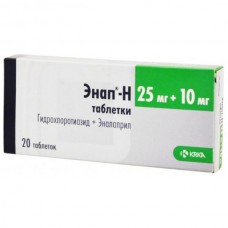Expiration date: 11/2025
THE COMPOSITION AND FORM OF ISSUE:
ENAP®-H
Tablets of 10 or 20mg + 25 mg blister, 20 or 60 pcs
Enalapril maleate 10mg or 20mg
Hydrochlorothiazide 25 mg
Other ingredients: lactose, dye E104 quinoline yellow, corn starch, calcium hydrophosphate, talc, sodium bicarbonate, magnesium stearate.
PHARMACOLOGICAL PROPERTIES:
Pharmacodynamics. The drug is a combination of ACE inhibitor (enalapril maleate) and diuretic (hydrochlorothiazide).
ACE is a peptidyl dipeptidase that catalyzes the conversion of angiotensin I into the Pressor substance angiotensin II. After absorption, enalapril is hydrolyzed to enalaprilat, which inhibits APF. The inhibition of ACE leads to a decrease in the level of angiotensin II in the blood plasma, which leads to an increase in renin activity in the blood plasma (due to the oppression of negative feedback when releasing renin) and a decrease in the secretion of aldosterone.
ACE is identical to kininase II. Enalapril can also block the breakdown of bradykinin, which is a powerful vasodepressor peptide. However, the role of this fact in the therapeutic effects of enalapril remains unknown. While the mechanism of lowering blood PRESSURE enalapril primarily associated with inhibition of the activity of renin-angiotensin-aldosterone system, which plays a major role in the regulation of blood PRESSURE, enalapril may exhibit antihypertensive effect even in patients with low-adenine AH.
Hydrochlorothiazide is a diuretic and antihypertensive agent that increases the activity of renin in blood plasma. The antihypertensive effects of the two components are additive and usually last 24 hours Despite the fact that separate exhibits enalapril antihypertensive effect even in patients with discontinuous of AG, the simultaneous use of hydrochlorothiazide in these patients leads to a more pronounced decrease in blood pressure. Enapril in the drug, as a rule, reduces the excretion of potassium, caused by the intake of hydrochlorothiazide.
Pharmacokinetics. Of enalapril maleate. After oral administration, enalapril is rapidly absorbed, reaching Cmax in the blood plasma for 1 hour. Based on the excretion index in the urine, the absorption of enalapril in oral administration is about 60-70%.
After absorption, enalapril is rapidly and extensively hydrolyzed to enalaprilat, a potent ACE inhibitor. Cmax enalaprilate in plasma is achieved in 3-4 hours after oral administration of enalapril maleate. Enalapril is excreted mainly by the kidneys. The main substance in the urine is enalaprilat-about 40% dose, and enalapril unchanged. With the exception of conversion to enalaprilat, there is no sign of significant metabolism of enalapril. The concentration profile of enalaprilate in blood plasma is characterized by a prolonged terminal phase, which is probably due to the binding of ACE. In persons with normal renal function, the equilibrium concentration of enalaprilat in blood plasma is achieved on the 4th day of oral administration of enalapril. Effective T½ enalaprilata after repeated oral administration of enalapril is 11 no. Meal does not affect the absorption of enalapril in the gastrointestinal tract. The volume of absorption and hydrolysis of enalapril are similar when taking different doses within the recommended therapeutic range.
Hydrochlorothiazide. When monitoring the levels in blood plasma for at least 24 hours T ½ of plasma was 5, 6-14, 8 h. Hydrochlorothiazide is not metabolized but rapidly excreted by the kidneys. In oral administration, at least 61% of the dose is excreted unchanged for 24 hours. Hydrochlorothiazide penetrates the placental barrier and does not penetrate the BBB.
Enalapril / hydrochlorothiazide. Simultaneous repeated use of enalapril and hydrochlorothiazide slightly or no effect on the bioavailability of these substances. A tablet containing a combination of two substances is bioequivalent to its individual components, which are used simultaneously.
INDICATIONS:
AH in patients who are indicated for combination therapy.
APPLICATION:
AG. Tablets with a fixed combination of enalapril maleate and hydrochlorothiazide are prescribed to patients whose blood PRESSURE is not sufficiently controlled by the use of enalapril alone.
The use of a fixed combination of enalapril maleate and hydrochlorothiazide is not suitable for initial therapy and is usually recommended after titration of doses of individual components. With clinical feasibility, you can move directly from monotherapy to a fixed combination.
The dosage regimen is set individually depending on the patient's condition and the severity of hypertension. Treatment begins with low doses of the drug with a gradual increase in dosage. The drug is administered orally with or without food. The established daily dose should be taken in the morning, drinking plenty of liquid.
Usually the dose is 1 tablet, which is used 1 time per day. If necessary, the dose can be increased to 2 tablets per day in one dose.
Tablets with a fixed combination of 10 mg/25 mg and 20 mg / 12, 5 mg can replace therapy, consisting of taking separately 10 or 20 mg of enalapril and 25 or 12, 5 mg of hydrochlorothiazide, respectively, in patients, the state of which is stabilized by the treatment of individual components.
Previous treatment with diuretics: symptomatic hypotension may occur at the beginning of drug therapy. More often detected in patients' whose previous diuretic therapy caused a violation of the water-electrolyte balance. Diuretic therapy should be discontinued 2-3 days before the start of therapy with the drug.
Dosing in violation of renal function. Creatinine clearance >30 ml/min For patients with impaired kidney with creatinine clearance ?30 ml/min before switching to the fixed combination of a correction dose of enalapril by titration. For such patients, loop diuretics are more acceptable than thiazides. The dose of enalapril and hydrochlorothiazide should be the lowest. Requires periodic monitoring of potassium and creatinine, for example, every 2 months in the stabilization of the patient.
Creatinine clearance <30 ml / min. the use of the drug is contraindicated.
Special categories of patients. For patients with electrolyte/fluid deficiency, the initial dose of enalapril is ?5 mg and monocomponents titration is recommended.
Dosing for elderly patients. The use of the drug in elderly patients is carried out in the same dose as in young. In the case of physiological renal failure before the transition to a fixed combination of necessary correction dose enalapril by titration.
There is no time limit regarding the duration of treatment.
CONTRAINDICATIONS:
Hypersensitivity to enalapril and other ACE inhibitors, hydrochlorothiazide and other derivatives of sulfonamides or other components of the drug; angioedema associated with the use of ACE inhibitors in history; hereditary or idiopathic angioedema; severe impaired renal function (creatinine clearance <30 ml/min or creatinine level in plasma of >265 µmol/l (3 mg/100 ml)); renal artery stenosis; during hemodialysis, a condition after kidney transplantation; severe disturbances of liver function; anuria; primary hyperaldosteronism; gestation period.



